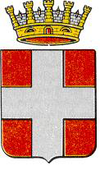Tuscania
| Tuscania | ||
|---|---|---|
| Comune | ||
| Comune di Tuscania | ||
 |
||
|
||
| Location of Tuscania in Italy | ||
| Coordinates: 42°25′N 11°52′E / 42.417°N 11.867°E | ||
| Country | Italy | |
| Region | Lazio | |
| Province / Metropolitan city | Viterbo (VT) | |
| Government | ||
| • Mayor | Fabio Bertolacci | |
| Area | ||
| • Total | 208.03 km2 (80.32 sq mi) | |
| Elevation | 165 m (541 ft) | |
| Population (30 November 2014) | ||
| • Total | 8,434 | |
| • Density | 41/km2 (110/sq mi) | |
| Demonym(s) | Tuscaniesi, Tuscanesi or Toscanellesi | |
| Time zone | CET (UTC+1) | |
| • Summer (DST) | CEST (UTC+2) | |
| Postal code | 01017 | |
| Dialing code | 0761 | |
| Patron saint | Sts. Secondianus, Verianus and Marcellianus Martyrs | |
| Saint day | August 8 | |
| Website | Official website | |
Tuscania is a town and comune in the province of Viterbo, Lazio Region, Italy. Until the late 19th century the town was known as Toscanella.
According to the legend, Tuscania was founded by Aeneas' son, Ascanius, where he had found twelve dog pups (whence the Etruscan name Tus-Cana, cana being similar to Latin canis for "dog"). Another legend attributes the foundation to one Tusco, son of Hercules and Araxes.
Evidence of human presence in the area dates from the Neolithic age, but probably the city proper was founded in the 7th century BC when the acropolis on St. Peter's Hill was surrounded by a line of walls. Villages existed in the vicinity. In the following years its strategic position gave Tuscania a leading role in the Etruscan world. After the defeat of the coastal cities by the Greeks (4th century BC), Tuscania also became a maritime trade centre through the port of Regas (next to today's Montalto di Castro). There is no record of Tuscania being involved in the battles that led to the Roman conquest of the Etruscan northern Lazio (280 BC), as the city probably entered into the Roman orbit peacefully. The agricultural development and construction of the Via Clodia further boosted the economic situation of the city. It became a municipium in 88 BCE.
In the 5th century AD (or earlier, depending on the source), Tuscania became one of the first bishopric sees in Italy.
After the fall of the Western Roman Empire, it fell to the Lombards in 569 or 574. In 781 it became part of the Papal States. In 967–1066 it was a fief of the Anguillara family and then of the marquises of Tuscany. In 1081 it was besieged by Emperor Henry IV.
...
Wikipedia


